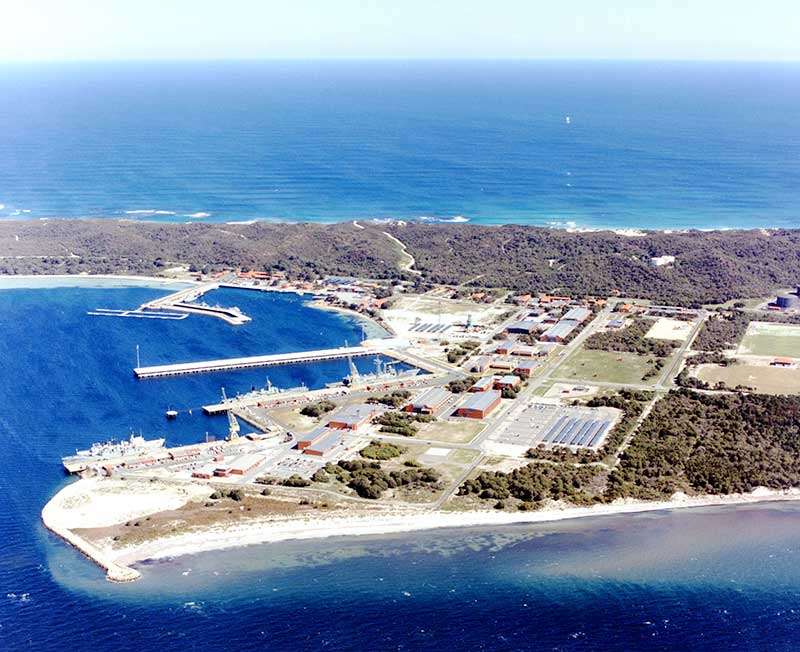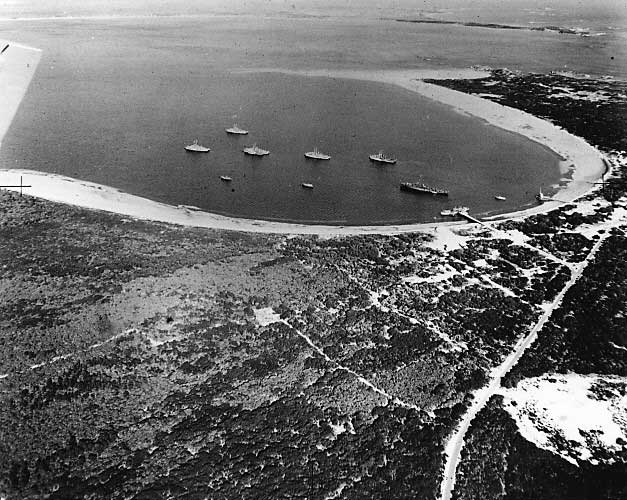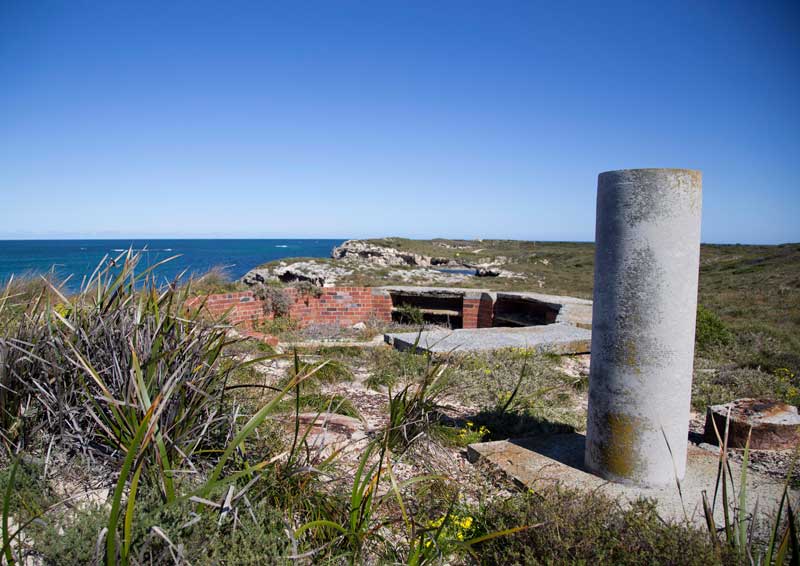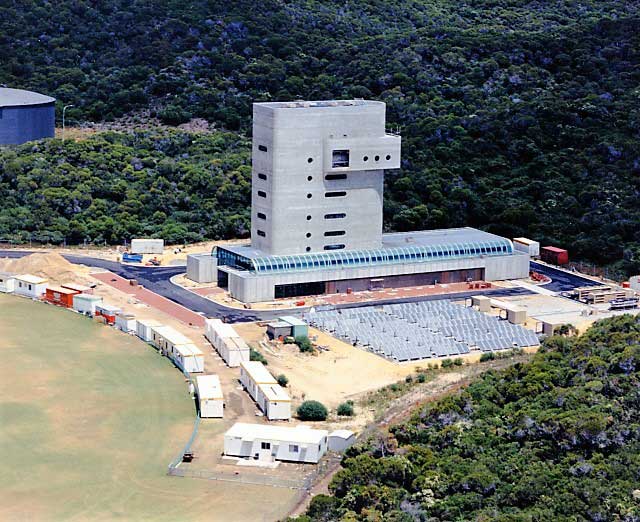Location & importance
Garden Island, 50 km south of Perth, WA is a slender 10 x 1.5 kilometre island lying about five kilometres off the Western Australian coast, to which it is now linked by bridge and causeway. The island, and in particular the Cliff Point Historic Site, has national heritage value as the site of first settlement in Western Australia and its association with Governor Stirling and Captain Charles Fremantle. It is also the location of HMAS Stirling and the RAN’s Fleet Base West.

National Heritage recognition of Garden Island is also due to its isolation from the Western Australian mainland. Garden Island is much as it was before European settlement, free of disturbance from humans or introduced animals. The absence of feral predators means the island provides a significant refuge for animals vulnerable to predation on the mainland. Species of particular interest include the Tammar wallaby (MACROPUS EUGENII), carpet python (MORELIA SPILOTA), and the lined skink (LERISTA LINEATA). Populations of the 14 species of reptile and the Tammar wallaby have been isolated from mainland populations for 6000-7000 years. The mature relatively undisturbed heath, scrub and low forest of Garden Island are especially important as a reference site for natural history.
It is likely that Indigenous values exist on Garden Island, but as yet these have not been identified, documented or assessed for National Estate significance by the Australian Heritage Commission.
History
Garden Island was first called Meeandip by the Aborigines, and Ile de Buache by the French following the visit of Nicholas Baudin in 1801. It was renamed Garden Island in 1829.
Towards the end of 1826 New South Wales Governor Darling in sent Major Lockyer to secure the King George Sound area (off present-day Albany) of Western Australia for the Crown. The garrison force under Major Lockyer helped free Aboriginal people who had been taken prisoner by sealers, the first Europeans to exploit the coastal regions of Western Australia. In 1827 Captain James Stirling, Royal Navy, visited the Swan River region, reporting favourably on the mainland and Garden Island for their agricultural potential. Before completing his mission, Stirling landed the remaining livestock from his ship on the island of Buache, as named by the 1801 French Naturaliste expedition. Captain Charles Fremantle, Royal Navy arrived at the island in 1829 to prepare for its settlement by the returning Captain Stirling. He named it Garden Island. Stirling, supported by over 400 people, arrived at the chosen site, Cliff Point, later that year. The makeshift community was called Sulphur Town after one of the transport vessels, but within two months the group had begun a shift to the Swan River settlement (now Fremantle) on the mainland. The remains of Sulphur Town burnt in 1834. A memorial now marks the Cliff Point Historic Site.

Garden Island was selected as the location for a naval base and resumed by the Commonwealth in 1911. Three years later a site on Careening Bay was used as an internment camp to house other nationals during the First World War.
The strategic role of Garden Island and Cockburn Sound was recognized during World War II when gun batteries were located there to protect shipping in the sheltered waters of the sound. Special training units including the Z Force Unit were also stationed there. The guns were removed in 1963, but their sites remain relatively intact.

Between 1945 and 1957, Garden Island was home to the Fremantle detachment of the RAN Reserve Fleet. In November 1969 the Government announced the intention to begin the development of a naval facility on the island, beginning with the construction of a 4.3km long causeway linking it to the mainland.
HMAS Stirling was officially commissioned on 28 July 1978, though ships began visiting the facility in August 1975. Its primary purpose is to provide operational and logistics support to the RAN ships, submarines and aircraft based in WA. In 1987 the Government announced the ‘Two-Ocean Basing Plan’ with the intention of establishing the RAN as a two-ocean navy capable of deploying major fleet units for sustained operations off both the east and west coasts. Up to half of the RAN’s surface submarine fleet was to be based permanently in Western Australia. The two main fleet bases became known as Fleet Base West (at Stirling) and Fleet Base East (centred on HMAS Kuttabul).
Since commissioning Stirling has expanded enormously within its existing boundaries and has seen building such as the Submarine Escape Training Facility – one of only six in the world, and the only one in the southern hemisphere – constructed. Some 12 Fleet units including the RAN frigates and submarines are stationed there, along with some 70 units including the Submarine Training and Systems Centre (STSC), a Clearance Diving Team and Defence Communications Station (DEFCOMMSTA) Perth.

Other major additions to Stirling have been the helicopter support facility located on the southern end of Garden Island, extensions to the RAN Submarine Training and Systems Centre, the Training Centre-West complex and a trials, research and support facility.
The fragility of Garden Island and its environment was recognised by Defence and some 50,000 indigenous trees and scrubs were planted to stabilise the soil and enhance the wildlife’s habitat.
Public Access
Approximately two-thirds of Garden Island is open to the public in daylight hours, provided visitors travel by private boat and leave before nightfall. Department of Conservation and Land Management Rangers patrol the coastline and provide assistance to visitors.
References
Cliff Point Historic Site: Government of WA, Heritage Council
Garden Island National Heritage Site: Department of Environment and Energy, National Heritage List
Captain Nicolas Baudin: Australian Dictionary of Biography, Volume 1, (MUP), 1966
Captain James Stirling: Australian Dictionary of Biography, Volume 2, (MUP), 1967
Captain Charles Fremantle: Wikipedia.com
History of HMAS Stirling: Royal Australian Navy, Sea Power Centre
“Z” Force Special Unit: Ozatwar. com